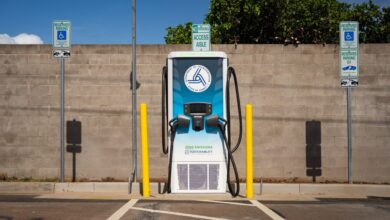Prediction: 3 Sensational Stocks That’ll Be Worth Far More Than Tesla 2 Years From Now

Three time-tested businesses have the necessary catalysts to blow past electric-vehicle (EV) maker Tesla by 2026.
For more than a year, the iconic Dow Jones Industrial Average, broadly followed S&P 500, and growth-driven Nasdaq Composite have been enjoying a true “running of the bulls.” While certain sectors and industries have taken turns contributing to the bull market, the “Magnificent Seven” have done most of the heavily lifting.
The Magnificent Seven represent seven of the largest and most-influential companies on Wall Street. In other words, they’re businesses lauded for their innovation and competitive advantages. In order of descending market cap, the Magnificent Seven are:
- Microsoft
- Apple
- Nvidia
- Alphabet
- Amazon
- Meta Platforms
- Tesla (TSLA -1.57%)
Image source: Getty Images.
Unfortunately for electric-vehicle (EV) manufacturer Tesla, it’s been anything but “magnificent” of late. Shares of the company are down 30% year-to-date and sit 57% below the company’s all-time high, which was set in 2021. With additional “breakdowns” likely for North America’s leading EV maker, a trio of brand-name businesses could handily leapfrog Tesla’s market cap over the coming two years.
Tesla stock appears headed for a breakdown
To give credit where credit is due, Tesla is the only pure-play EV maker that’s generating a recurring profit, based on generally accepted accounting principles (GAAP). It’s also the first automaker to have successfully built itself from the ground up to mass production in well over a half-century. But this is where the praise ends.
With EV and hybrid competition increasing domestically and abroad, Tesla has had no choice but to aggressively reduce the sales price of its fleet (Models 3, S, X, and Y). Following more than a half-dozen steep price reductions since the start of last year, Tesla’s operating margin has plummeted from 17.2% (as of Sept. 30, 2022) to just 5.5%, as of March 31, 2024. There’s no indication that margins are going to find a floor anytime soon.
Another problem for Tesla is how it generates its income. The rightful assumption is that an automaker is generating its profits from selling vehicles. However, Tesla brought in 51% of its pre-tax income in the March-ended quarter from unsustained sources that include the sale of regulatory tax credits to other automakers and interest income earned on its cash. It also endured a free cash outflow of $2.53 billion.
But perhaps the most damning thing for Tesla stock is its CEO. Though Elon Musk is a visionary, he’s also proved to be a massive liability for his company. He’s made countless promises about full self-driving and robotaxis that haven’t come close to fruition. If these promises are backed out of Tesla’s valuation, the following three sensational companies should have no trouble surpassing its market cap over the next two years.
Mastercard: Current market cap of $423 billion
The first longtime outperformer that can shoot well past Tesla’s market cap in the coming two years is payment processor Mastercard (MA 0.16%).
Mastercard undeniably benefits from its cyclical ties. This is to say that if the U.S. and global economy are expanding, consumers and businesses are willingly spending more. Even though recessions are a normal part of the economic cycle, they historically don’t last very long. This allows Mastercard and its payment-facilitating peers to take advantage of long-winded periods of growth.
Furthermore, Mastercard’s management team has steered clear of the lending arena. While I have little doubt the company would be successful as a lender, doing so would mean contending with potential credit delinquencies and loan losses during inevitable economic downturns. Since Mastercard has remained solely focused on payment facilitation, it’s not constrained by having to set aside capital to cover loan losses like lending institutions. In short, this helps it quickly bounce back from economic downturns.
Investors may not realize just how vast the growth runway is for Mastercard. In addition to being the clear No. 2 payment processor by credit card network purchase volume in the U.S., it can expand its network organically or acquisitively into chronically underbanked regions of the world, such as Africa, the Middle East, and Southeastern Asia. Mastercard can easily sustain a double-digit annual growth rate for a long time to come.
Image source: Getty Images.
Johnson & Johnson: Current market cap of $358 billion
A second sensational business that I firmly believe will close the nearly $200 billion valuation gap with Tesla and vault well ahead of North America’s leading EV maker over the coming two years is healthcare conglomerate Johnson & Johnson (JNJ 0.60%).
The beautiful thing about healthcare stocks is that they’re defensive. People don’t suddenly stop becoming ill or needing treatment if the U.S. economy falls into a recession. Demand for prescription drugs and medical devices remains consistent in pretty much any economic climate. This helps to explain why Johnson & Johnson was able to grow its adjusted operating earnings every year for more than three decades.
Johnson & Johnson has notably benefited from its decade-long focus on novel-drug development. Shifting its attention to developing brand-name therapies has afforded J&J exceptional pricing power and lifted its gross margin. J&J’s pristine balance sheet and sustainable operating cash flow allows the company to continually invest in internal research and forge collaborations.
Don’t overlook Johnson & Johnson’s rock-solid management team, either. You can count the number of CEOs J&J has had since its founding in 1886 using the fingers on only two hands. Consistency in key leadership positions has led to sustained operating earnings growth and a dividend that’s expanded for 62 consecutive years.
Johnson & Johnson is a perfect example of how the turtle (J&J) can beat the hare (Tesla) over time.
Chevron: Current market cap of $300 billion
In an ironic twist, the third sensational company I predict will be worth far more than Tesla two years from now is integrated oil and gas titan Chevron (CVX 1.79%). Chevron will need to overcome a $257 billion valuation gap to match Wall Street’s most-valuable EV manufacturer.
One of the things that makes Chevron special is the “integrated” aspect of its operating structure. Though it generates the lion’s share of its operating income from its drilling operations, Chevron also oversees transmission pipelines, chemical plants, and refineries. These midstream and downstream assets provide predictable operating cash flow and can act as a hedge in the event that the spot price of crude oil declines. No matter what’s thrown Chevron’s way, it’s had no trouble increasing its dividend in each of the past 37 years.
Macroeconomic factors should benefit Chevron’s drilling operations, as well. During the COVID-19 pandemic, major energy companies (including Chevron) had little choice but to slash their capital spending due to demand uncertainty. Years of reduced investment, coupled with Russia’s invasion of Ukraine, has tightened the global supply of oil. With no quick fix in sight, the spot price of crude oil should remain above its historic norm and provide a lift to Chevron’s highest-margin segment.
Lastly, Chevron is in the process of acquiring Hess in an all-share deal valued at $53 billion. Assuming the deal closes as planned, Chevron will beef up its oil equivalent production in Guyana, as well as gain access to 465,000 net acres of oil-rich land in the Bakken Shale.
Whereas Tesla’s valuation to other automakers remains otherworldly, Chevron’s stock is historically cheap.
Randi Zuckerberg, a former director of market development and spokeswoman for Facebook and sister to Meta Platforms CEO Mark Zuckerberg, is a member of The Motley Fool’s board of directors. Suzanne Frey, an executive at Alphabet, is a member of The Motley Fool’s board of directors. John Mackey, former CEO of Whole Foods Market, an Amazon subsidiary, is a member of The Motley Fool’s board of directors. Sean Williams has positions in Alphabet, Amazon, Mastercard, and Meta Platforms. The Motley Fool has positions in and recommends Alphabet, Amazon, Apple, Chevron, Mastercard, Meta Platforms, Microsoft, Nvidia, and Tesla. The Motley Fool recommends Johnson & Johnson and recommends the following options: long January 2025 $370 calls on Mastercard, long January 2026 $395 calls on Microsoft, short January 2025 $380 calls on Mastercard, and short January 2026 $405 calls on Microsoft. The Motley Fool has a disclosure policy.



